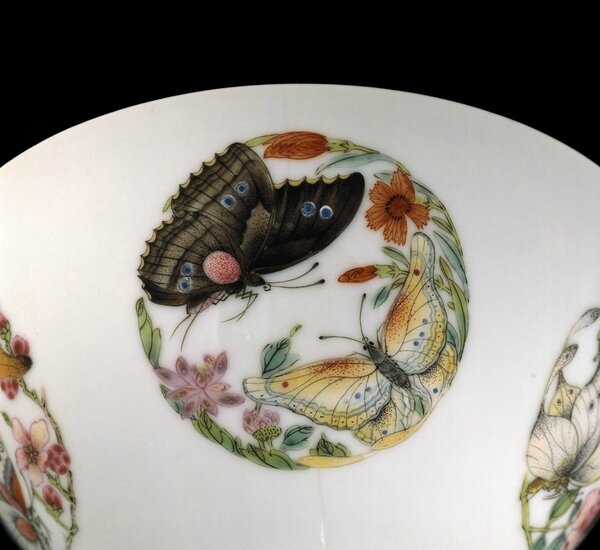Famille rose bowl vase with butterfly medallions, Qing dynasty, Yongzheng period (AD 1723-35),

Famille rose bowl vase with butterfly medallions, Qing dynasty, Yongzheng period (AD 1723-35), Jingdezhen, Jiangxi province, southern China. Height: 2.700 inches - Diameter: 5.200 inches. Bequeathed by Reginald R. Cory. Asia OA 1936.4-13.26. British Museum © Trustees of the British Museum.
Accordingly to Chinese tradition, butterflies are an auspicious sign. They convey a wish for longevity, and were therefore often used to decorate birthday gifts or lanterns given during the Autumn Moon Festival: on the 15th day of the 8th month of the lunar calendar (usually around September). The Festival is celebrated by lighting lanterns of different shapes, sizes and colours, and by gazing at the moon. This bowl, made at the imperial kilns at Jingdezhen, may have been presented by the emperor to a family member or worthy subject on such an occasion.
The bowl is decorated in famille rose overglaze enamels. This technique was perfected under the Yongzheng emperor (reigned AD 1723-35) and is considered the last major technological breakthrough at the Jingdezhen kilns. The great innovation was the production of the distinctive pink enamel from which the wares take their name. The pink colour was provided by adding a very small amount of gold to red pigment. The resulting colour was opaque, as were the other famille rose enamels, and so could be mixed to create a wider range of colours than had been possible before.
S.J. Vainker, Chinese pottery and porcelain, (London, The British Museum Press, 1991)
J. Harrison-Hall, 'Chinese porcelain from Jingdezhen' in Pottery in the making: worl-10 (London, The British Museum Press, 1997), pp. 194-99

/https%3A%2F%2Fprofilepics.canalblog.com%2Fprofilepics%2F1%2F0%2F100183.jpg)
/https%3A%2F%2Fstorage.canalblog.com%2F03%2F02%2F119589%2F96711876_o.jpg)
/https%3A%2F%2Fstorage.canalblog.com%2F11%2F31%2F119589%2F94773502_o.jpg)
/https%3A%2F%2Fstorage.canalblog.com%2F20%2F83%2F119589%2F94772815_o.jpg)
/https%3A%2F%2Fstorage.canalblog.com%2F26%2F72%2F119589%2F75604929_o.jpg)
/https%3A%2F%2Fstorage.canalblog.com%2F59%2F60%2F119589%2F26458628_o.jpg)


/http%3A%2F%2Fstorage.canalblog.com%2F91%2F48%2F119589%2F128923043_o.jpg)
/http%3A%2F%2Fstorage.canalblog.com%2F84%2F09%2F119589%2F128922928_o.jpg)
/http%3A%2F%2Fstorage.canalblog.com%2F74%2F57%2F119589%2F128709421_o.jpg)
/http%3A%2F%2Fstorage.canalblog.com%2F96%2F72%2F119589%2F128683141_o.jpg)